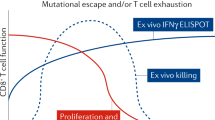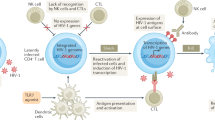Abstract
Combination antiretroviral therapy potently suppresses HIV replication, but does not eradicate the infection. Drug resistance and long-term toxicities limit its use. The recovery of general immune function is often not complete. Immune-based therapies have the potential to boost HIV-specific immunity and reduce the need for antiretroviral drugs, and to promote general immune competence in situations in which antiretroviral treatment alone is inadequate. Strategies to reduce the immunopathogenic consequences of HIV infection with immunomodulating therapies are conceivable. Ultimately, eradication of the infection will require methods to target the latent memory T-cell reservoir of virus.
Similar content being viewed by others
References and Recommended Reading
Zhang L, Ramratnam B, Tenner-Racz K, et al.: Quantifying residual HIV-1 replication in patients receiving combination antiretroviral therapy. New Engl J Med 1999, 340:1605–1613.
Ramratnam B, Mittler JE, Zhang L, et al.: The decay of the latent reservoir of replication-competent HIV-1 is inversely correlated with the extent of residual viral replication during prolonged antiretroviral therapy. Nat Med 2000, 6:82–85.
Di Mascio M, Dornadula G, Zhang H, et al.: In a subset of patients on highly active antiretroviral therapy, HIV type-1 RNA in plasma decays from 50 to less than five copies per milliliter, with a half-life of 6 months. J Virol 2003, 77:2271–2275.
Siliciano JD, Kajdas J, Finzi D, et al.: Long-term follow-up studies confirm the stability of the latent reservoir for HIV-1 in resting CD4+ T cells. Nat Med 2003, 9:727–728.
Yeni PG, Hammer SM, Hirsch MS, et al.: Treatment for adult HIV infection: 2004 recommendations of the International AIDS Society-USA panel. JAMA 2004, 292:251–265.
Bartlett JA, Miralles GD, Sevin AD, et al.: Addition of cyclophosphamide to antiretroviral therapy does not diminish the cellular reservoir in HIV-infected persons. AIDS Res Hum Retroviruses 2002, 18:535–543.
Kulosky J, Nunnari G, Otero M, et al.: Intensification and stimulation therapy for HIV type-1 reservoirs in infected persons receiving virally suppressive highly active antiretroviral therapy. J Infect Dis 2002, 186:1403–1411.
Stellbrink HJ, van Lunzen J, Westby M, et al.: Effects of IL-2 plus highly active antiretroviral therapy on HIV-1 replication and proviral DNA (COSMIC trial). AIDS 2002, 16:1479–1487.
Hatano H, Vogel S, Yoder C, et al.: Pre-HAART HIV burden approximates post-HAART viral levels following interruption of therapy in patients with sustained viral suppression. AIDS 2000, 14:1357–1363.
Silvestri G, Sodora DL, Koup RA, et al.: Nonpathogenic SIV infection of sooty mangabeys is characterized by limited bystander immunopathology despite chronic high-level viremia. Immunity 2003, 18:441–452.
Cao Y, Qin L, Zhang L, et al.: Virologic and immunologic characterization of long-term survivors of HIV type-1 infection. N Engl J Med 1995, 332:201–208.
Pantaleo G, Menzo S, Vaccarezza M, et al.: Studies in subjects with long-term nonprogressive human immunodefiency virus infection. N Engl J Med 1995, 332:209–216.
Johnson WE, Desrosiers RC: Viral persistence: HIV’s strategies of immune system evasion. Annu Rev Med 2002, 53:499–518. Review of mechanisms of HIV evasion of immune response.
Lange CG, Lederman MM: Immune reconstitution with antiretroviral therapies in chronic HIV-1 infection. J Antimicrob Chemother 2003, 51:1–4. Review of restoration of immune function with antiretroviral therapy.
RA, Safrit JT, Cao Y, et al.: Temporal association of cellular immune responses with the initial control of viremia in primary HIV type-1 syndrome. J Virol 1994, 68:4650–4655.
Schmitz JE, Kuroda MJ, Santra S, et al.: Control of viremia in SIV infection by CD8+ lymphocytes. Science 1999, 283:857–860.
Shiver JW, Fu TM, Chen L, et al.: Replication-incompetent adenoviral vaccine vector elicits effective anti-immunodeficiency-virus immunity. Nature 2002, 415:331–335.
Prince AM, Reesink H, Pascual D, et al.: Prevention of HIV infection by passive immunization with HIV immunoglobulin. AIDS Res Hum Retroviruses 1991, 7:971–973.
Gauduin MC, Parren PW, Weir R, et al.: Passive immunization with a human monoclonal antibody protects hu-PBL-SCID mice against challenge by primary isolates of HIV-1. Nat Med 1997, 3:1389–1393.
Mascola JR, Lewis MG, Stiegler G, et al.: Protection of Macaques against pathogenic simian/human immunodeficiency virus 89.6PD by passive transfer of neutralizing antibodies. J Virol 1999, 73:4009–4018.
Mascola JR, Stiegler G, VanCott TC, et al.: Protection of macaques against vaginal transmission of a pathogenic HIV-1/SIV chimeric virus by passive infusion of neutralizing antibodies. Nat Med 2000, 6:207–210.
Altfeld M, Allen TM, Yu XG, et al.: HIV-1 superinfection despite broad CD8+ T-cell responses containing replication of the primary virus. Nature 2002, 420:434–439.
Wyand MS, Manson K, Montefiori DC, et al.: Protection by live, attenuated SIV against heterologous challenge. J Virol 1999, 73:8356–8363.
Gourley TS, Wherry EJ, Masopust D, Ahmed R: Generation and maintenance of immunologic memory. Semin Immunol 2004, 16:323–333.
Lu W, Arraes LC, Ferreira WT, Andrieu JM: Therapeutic dendritic-cell vaccine for chronic HIV-1 infection. Nat Med 2004, 10:1359–1365.
Pett SL, Kelleher AD: Cytokine therapies in HIV-1 infection: present and future. Expert Rev Anti Infect Ther 2003, 1:83–96.
Waldmann TA: IL-15 in the life and death of lymphocytes: immunotherapeutic implications. Trends Mol Med 2003, 9:517–521.
Kojima Y, Xin KQ, Ooki T, et al.: Adjuvant effect of multi-CPG motifs on an HIV-1 DNA vaccine. Vaccine 2002, 20:2857–2865.
Ozpolat B, Rao XM, Powell MF, Lachman LB: Immunoliposomes containing antibodies to costimulatory molecules as adjuvants for HIV subunit vaccines. AIDS Res Hum Retroviruses 1998, 14:409–417.
Levy Y, Gahery-Segard H, Durier C, et al.: Immunological and virological efficacy of ALVAC-HIV 1433 and HIV lipopeptides (Lipo-6T0 combined with sc IL-2 in chronically HIV-infected patients: results of the ANRS 093 randomized study. Proceedings from the 10th Conference on Retroviruses and Opportunistic Infections 2003. Boston: Foundation for Retrovirology and Human Health; February 10–14, 2003: 62.
Kinloch S, Perrin L, Hoen B, et al.: Evaluation of two HIVtherapeutic vaccination regimens in HAART-treated primary HIV-infection subjects following analytical treatment interruption: QUEST PROB3005, a randomized, placebo-controlled study. Proceedings from the 11th Conference on Retroviruses and Opportunistic Infections 2004. San Francisco: Foundation for Retrovirology and Human Health; February 10–14, 2004:168.
Grabar S, Le Moing V, Goujard C, et al.: Clinical outcome of patients with HIV-1 infection according to immunologic and virologic response after 6 months of highly active antiretroviral therapy. Ann Intern Med 2000, 133:401–410.
Piketty C, Weiss L, Thomas F, et al.: Long-term clinical outcome of HIV-infected patients with discordant immunologic and virologic responses to a protease inhibitor-containing regimen. J Infect Dis 2001, 183:1328–1335.
Dronda F, Moreno S, Moreno A, et al.: Long-term outcomes among antiretroviral-naïve HIV-infected patients with small increases in CD4+ cell counts after successful virologic suppression. Clin Infect Dis 2002, 35:1005–1009.
Chene G, Sterne JA, May M, et al.: Prognostic importance of initial response in HIV-1-infected patients starting potent antiretroviral therapy: analysis of prospective studies: Lancet 2002,360:679–686. Large cohort study which demonstrated that CD4 cell count and HIV RNA level 6 months after initiation of antiretroviral treatment are the best predictors of clinical outcome.
Anastos K, Barron Y, Cohen MH, et al.: The prognostic importance of changes in CD4+ cell count and HIV-1 RNA level in women after initiating highly active antiretroviral therapy. Ann Intern Med 2004, 140:256–264.
Coakley EPG, Samore MH, Gillis JM, et al.: The values of quantitative serum HIV-1 RNA levels and CD4 cell counts for predicting survival time among HIV-positive individuals with CD4 counts of less than 50 x 106 cells per l. AIDS 2000, 14:1147–1153.
Douek DC, McFarland RD, Keiser PH, et al.: Changes in thymic function with age and during the treatment of HIV infection. Nature 1998, 396:690–695.
Ye P, Kourtis AP, Kirschner DE: The effects of different HIV-1 strains on human thymic function. AIDS Res Hum Retroviruses 2002, 18:1239–1251.
Kolte L, Dreves AM, Ersboll AK, et al.: Association between larger thymic size and higher thymic output in HIV-infected patients receiving highly active antiretroviral therapy. J Infect Dis 2002, 185:1578–1585.
Auernhammer CJ, Stracburger CJ.: Effects of growth hormone and insulin-like growth factor I on the immune system. Eur J Endocrinol 1995, 133:635–645.
Napolitano LA, Lo JC, Gotway MB, et al.: Increased thymic mass and circulating naive CD4 T cells in HIV-1-infected adults treated with growth hormone. AIDS 2002, 16:1103–1111.
Pires A, Pido-Lopez J, Moyle G, et al.: Enhanced T-cell maturation, differentiation, and function in HIV-1 infected individuals after growth hormone and highly active antiretroviral therapy. Antivir Ther 2004, 9:67–75.
Nguyen BY, Clerici M, Venzon DJ, et al.: Pilot study of the immunologic effects of recombinant human growth hormone and recombinant insulin-like growth factor in HIV-infected patients. AIDS 1998, 12:895–904.
Vigano A, Saresella M, Trabattoni D, et al.: Growth hormone in T-lymphocyte thymic and post-thymic development: a study in HIV-infected children. J Pediatr 2004, 145:542–548.
Jacobson JM, Lederman MM, Spritzler J, et al.: Granulocytemacrophage colony stimulating factor induces modest increases in plasma HIV type-1 RNA levels and CD4+ lymphocyte counts in patients with uncontrolled HIV infection. J Infect Dis 2003, 188:1804–1814.
Min D, Taylor PA, Panoskaltsis-Mortari A, et al.: Protection from thymic epithelial cell injury by keratinocyte growth factor: a new approach to improve thymic and peripheral T-cell reconstitution after bone marrow transplantation. Blood 2002, 99:4592–4600.
Revest JM, Suniara RK, Kerr K, et al.: Development of the thymus requires signaling through the fibroblast growth factor receptor R2-IIIb. J Immunol 2001, 167:1954–1961.
Rossi S, Blazar BR, Farrell CL, et al.: Keratinocyte growth factor preserves normal thymopoiesis and thymic microenvironment during experimental graft-versus-host disease. Blood 2002, 100:682–91.
Farel CE, Chaitt DG, Hahn BK, et al.: Induction and maintenance therapy with intermittent IL-2 in HIV-1 infection. Blood 2004, 103:3282–3286. Reports experience with long-term IL-2 therapy.
Marchetti G, Meroni L, Varchetta S, et al.: Low-dose prolonged intermittent IL-2 adjuvant therapy: results of a randomized trial among human immunodeficiency virus-positive patients with advanced immune impairment. J Infect Dis 2002, 186:606–616.
Katlama C, Carcelain G, Duvivier C, et al.: IL-2 accelerates CD4 cell reconstitution in HIV-infected patients with severe immunosuppression despite highly active antiretroviral therapy: the ILSTIM study-ANRS 082. AIDS 2002, 16:2027–2034.
Markowitz N, Bebchuk JD, Abrams DI, Terry Beirn: Community Program for Clinical Research on AIDS. Nadir CD4+ Tcell count predicts response to subcutaneous recombinant interleukin-2. Clin Infect Dis 2003, 37:115–120.
Fry TJ, Mackall CL: IL-7: master regulator of peripheral T-cell homeostasis? Trends Immunol 2001, 22:564–571.
Fry TJ, Moniuszko M, Creekmore S, et al.: IL-7 therapy dramatically alters peripheral T-cell homeostasis in normal and SIVinfected nonhuman primates. Blood 2003, 101:2294–2299.
Napolitano LA, Grant RM, Deeks SG, et al.: Increased production of IL-7 accompanies HIV-1-mediated T-cell depletion: implications for T-cell homeostasis. Nat Med 2001, 7:73–79.
Fry TJ, Connick E, Falloon J, et al.: A potential role for IL-7 in T-cell homeostasis. Blood 2001, 97:2983–2990.
Muro-Cacho CA, Pantaleo G, Fauci AS: Analysis of apoptosis in lymph nodes of HIV-infected persons. Intensity of apoptosis correlates with the general state of activation of the lymphoid tissue and not with stage of disease or viral burden. J Immunol 1995, 154:5555–5566.
Bucy RP, Hockett RD, Derdeyn CA, et al.: Initial increase in blood CD4(+) lymphocytes after HIV ART reflects redistribution from lymphoid tissues. J Clin Invest 1999, 103:1391–1398.
Andersson J, Fehniger TE, Patterson BK, et al.: Early reduction of immune activation in lymphoid tissue following highly active HIV therapy. AIDS 1998, 2:F123-F129.
Andrieu JM, Even P, Venet A, et al.: Effects of cyclosporin on T-cell subsets in human immunodeficiency virus disease. Clin Immunol Immunopathol 1988, 47:181–198.
Calabrese, LH, Lederman MM, Spritzler J: Placebo-controlled trial of cyclosporine-A in HIV-1 disease: implications for solid organ transplantation. J Acquir Immune Defic Syndr 2002, 29:356–362.
Rizzardi GP, Harari A, Capilluppi B, et al.: Treatmen of primary HIV-1 infection with cyclosporine A coupled with HAART. J Clin Invest 2002, 109:681–688.
Wallis RS, Kalayjian R, Jacobson JM, et al.: A study of the immunology, virology, and safety of prednisone in HIV-1-infected subjects with CD4 cell counts of 200 to 700/mm3. J Acquir Immune Defic Syndr 2003, 32:281–286.
McComsey GA, Whalen CC, Mawhorter SD, et al.: Placebocontrolled trial of prednisone in advanced HIV-1 infection. AIDS 2001, 15:321–327.
Hamer DH: Can HIV be cured? Mechanisms of HIV persistence and strategies to combat it. Curr HIV Res 2004, 2:99–111. Review of potential strategies for targeting the latent T cell HIV reservoir.
Author information
Authors and Affiliations
Rights and permissions
About this article
Cite this article
Jacobson, J.M. Immune-based therapies: An adjunct to antiretroviral treatment. Curr HIV/AIDS Rep 2, 90–97 (2005). https://doi.org/10.1007/s11904-005-0024-4
Issue Date:
DOI: https://doi.org/10.1007/s11904-005-0024-4




